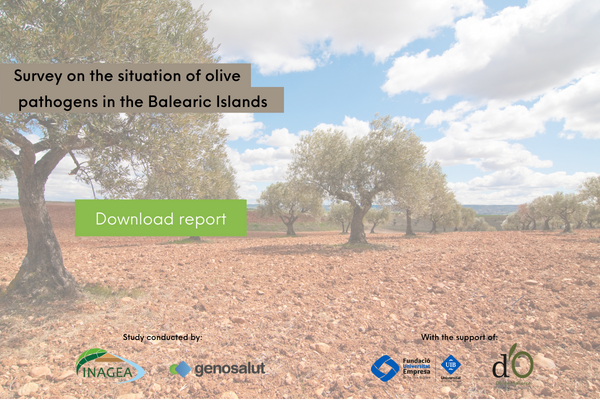What is OLITECH?
OLITECH is a research and development project that represents the continuation of a collaboration between INAGEA (Institute for Agri-environmental Research and Water Management) and Genosalut (biotechnology company in the Balearic Islands).
Molecular techniques for the early detection of pathogens will contribute to the control of plant diseases and allow a more rational use of conventional chemical agents and a more accurate application of biocontrol agents.
The project is being carried out thanks to the financial help of the ACCELERA programme of the FUEIB (Foundation for University and Economy of the Balearic Islands) and the support of the Oli de Mallorca Denomination of Origin.
What are the objectives of this project?
The objectives of this project can be divided into a first phase of gathering information and a second phase of practical development.
● In the first phase, which took place during the months of August and September 2022, a questionnaire was sent out to the main stakeholders in the Mallorcan olive sector. The aim was to find out first-hand what farmers’ concerns were regarding the main pathogens affecting the crop.
● Based on the results of the survey, which are summarised in the following section, a laboratory detection (using qPCR-HRM) and a kit for the in situ detection of Venturia oleaginea, the fungus that causes eyespot, will be developed in the second phase.
Olive scab, the biggest concern
A total of 34 olive farm representatives took part in the survey. This is a significant example of diversity in Mallorca, as it groups together farms with different characteristics in terms of location, size, farm type, production type and olive tree variety. Detailed results can be found in the report (in Spanish) on the survey.
As far as pathogens are concerned, and in particular micro-organisms, fungi, especially Venturia oleaginea, are the main cause of concern. Other fungi that are considered problematic to a lesser extent are Rosellinia necatrix, Colletotrichum, Verticillium dahliae and Pseudomonas savastanoi. Xylella and insects (Saissetia oleae Bern, Bactrocera oleae and Pollinia pollini) are also of concern.
Detection methods used
Most of the respondents perform only a visual inspection of the symptoms associated with a disease as the main method of detection. The problem is that this method does not allow early disease surveillance and can lead to misleading identification of certain pathogens that cause similar symptomatology.
Molecular technologies for early detection of plant pathogens
The control of pathogens requires a new set of tools, including disease surveillance and improved detection technologies. Molecular technologies are presented here as a reliable, accurate, rapid and cost-effective tool that can be used in situ for early detection of plant pathogens.
If you like our blog, subscribe to our newsletter



